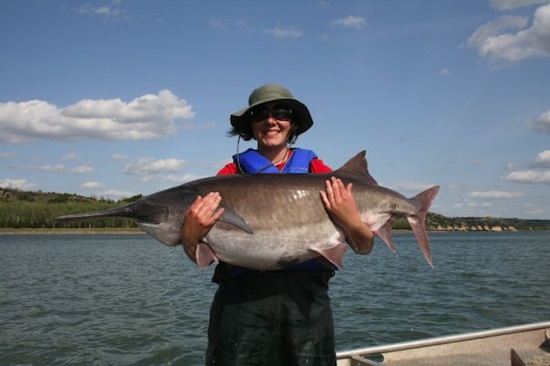UW study proposes “swimways” to help save migratory fish

Brenda Pracheil, a postdoctoral fellow at the UW–Madison Center for Limnology, cradles a paddlefish, a fish that migrates long distances through freshwater systems and that would benefit from “swimways,” aquatic corridors similar to flyways that would work to extend uniform protection to fish that cross state lines and game jurisdictions.
Photo: Dan Kolterman, Flordia Fish and Wildlife Conservation Commission
A University of Wisconsin–Madison researcher says states should be looking to the skies in order to save fish.
Brenda Pracheil, a postdoctoral fellow at the UW–Madison Center for Limnology, thinks it’s time for fish to garner the same protection afforded migratory birds. Migratory birds are protected by the federal Migratory Bird Treaty Act of 1918, and state collaboration and federal oversight span borders and encompass large conservation efforts in migratory flyways, especially for waterfowl.
But many freshwater fish migrate, too, says Pracheil. In fact, she notes, some work their way through thousands of miles of water and cross half a dozen state lines in the process. And that’s why, she argues, fish need “swimways.”
Historically, fisheries have been managed on a state-by-state basis. The result is a patchwork of protection and spotty data on things like habitat, range and population numbers — data that can show researchers and managers how different species are faring or where they’re moving.
“[Fish aren’t] like migratory birds where we have a reasonable idea of who goes where and when,” she explains. “For freshwater fish on a global scale, we don’t know where they go or how far they go or how often they go. We don’t know any of these big scale movements.”
To begin to understand fish movements, Pracheil and her colleagues at the University of Nebraska-Lincoln and the Nebraska Game and Parks Commission analyzed a database kept by the Mississippi Interstate Cooperative Resource Association (MICRA), an organization of 28 state natural resource offices. MICRA was formed in 1991 to address the lack of federal oversight of the nation’s fish. Migratory bird movements and numbers are kept in the centralized Migratory Bird Data Center and managed by the U.S. Fish and Wildlife Service and the U.S. Geological Survey. Fisheries managers, however, have no such resource when studying and managing fish passing in and out of different waterways each year.
Enter the MICRA. After evaluating data on more than 2 million fish, Pracheil says one fact was obvious: fish get around.
“There are some movements in this database where a fish swims from Kentucky to South Dakota. We don’t know what’s up with that. Why is it moving? Is it bored? Is it spawning? We have no clue.”
For their study, published this month (October 2012) in the journal Fisheries, Pracheil’s team focused on the American paddlefish. The paddlefish is a perfect case study because of its global importance in the lucrative caviar industry, and because no one can seem to agree on the health of paddlefish populations.
For example, in Ohio paddlefish are listed as “threatened” and are off-limits to both commercial and sport fishermen. But on the other side of the Ohio River in Kentucky, paddlefish are commercially harvested for caviar.
That bipolar approach to managing a shared resource is the cause of conflict and concern. Not only might a sensitive fish population be overharvested, but fishermen can get tangled up in the different approaches of state and federal agencies. Earlier this year, some Kentucky fishermen anchored one end of their gillnets to the Ohio side of the river in pursuit of paddlefish. “Even though it’s perfectly legal to harvest paddlefish in Kentucky, they got in huge trouble,” says Pracheil.
The problem, the study’s authors contend, is that state fisheries managers are trying to work within a framework that is drawn by geopolitical lines and not “biologically relevant” ones. That can lead to confusion. A birder looking for orioles in Costa Rica in July might conclude the bird is extinct, if we weren’t aware that songbirds spend their summers in North America, Pracheil notes. But, with migratory fish, no one knows where they should be, when they should arrive, or how many to expect.
Getting a handle on whole-system fish movements and population numbers is crucial to preserving freshwater fish species, the Wisconsin researcher argues. A September report in the journal BioScience found North American freshwater fish populations were going extinct at an alarming and accelerating rate. Pracheil worries that the paddlefish is no exception and that its status as a sought-after commercial fish will only make things worse.
“As the global sturgeon caviar fisheries collapse,” she says, “the paddlefish is becoming increasingly more valuable as a caviar fish. For example, a couple of years ago [the federal government] declared the shovelnose sturgeon endangered and, because of this, Illinois had to up their paddlefish permits by 30 percent.”
No one knows if Illinois’s increased take is sustainable for paddlefish populations, but Pracheil says centralized oversight and management on a species-range scale and protected corridors of “swimways” might begin to provide some answers.
“In order to buffer freshwater fish populations against the threats we have coming at us, like climate change, booming fish markets and increased human pressure on water resources,” she says, “we need to be progressive and forward thinking about how we manage fisheries.”
—Adam Hinterthuer
Tags: biosciences, research



